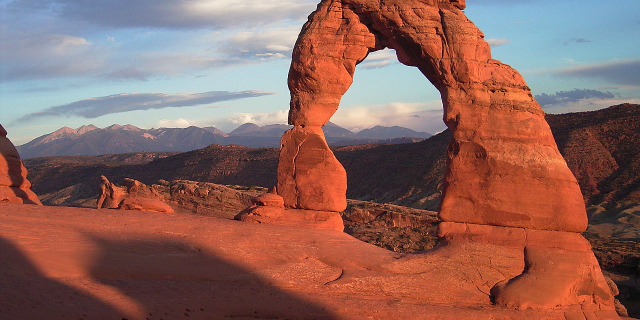Goblin Valley State Park
Goblin Valley State Park is a state park of Utah, in the United States. The park features thousands of hoodoos, referred to locally as goblins, which are formations of mushroom-shaped rock pinnacles, some as tall as several yards (meters). The distinct shapes of these rocks result from an erosion-resistant layer of rock atop relatively softer sandstone. Goblin Valley State Park and Bryce Canyon National Park, also in Utah about 190 miles (310 km) to the southwest, contain some of the largest occurrences of hoodoos in the world.
The park lies within the San Rafael Desert on the southeastern edge of the San Rafael Swell, north of the Henry Mountains. Utah State Route 24 passes about four miles (6.4 km) east of the park. Hanksville lies 12 miles (19 km) to the south.
 Coffee table arch (collapsed in early 2000s)
Coffee table arch (collapsed in early 2000s)Evidence of Native American cultures, including the Fremont, Paiute, and Ute, is common throughout the San Rafael Swell in the form of pictograph and petroglyph panels. Goblin Valley is noted for several rock art panels, as well as the rock formations.[1] The secluded Goblin Valley was then found by cowboys searching for cattle. Then, in the late 1920s, Arthur Chaffin, later owner/operator of the Hite Ferry, and two companions, were searching for an alternate route between Green River and Caineville. They came to a vantage point about 1 mile (1.6 km) west of Goblin Valley and were awed by what they saw – five buttes and a valley of strange, goblin-shaped rock formations surrounded by a wall of eroded cliffs. In 1949, Chaffin returned to the area he called the Valley of the Mushrooms. He spent several days exploring the mysterious valley and photographing its scores of intricately eroded rocks.[2]
Publicity attracted visitors to the valley despite its remoteness. In 1954, it was proposed that Goblin Valley be protected from vandalism. The state of Utah later acquired the property and established Goblin Valley State Reserve. It was officially designated a state park on August 24, 1964.[3] In 2019, the state park was expanded by adding 6,261 acres of federal land.[4]
2013 vandalism A naturally fallen hoodoo, not the vandalized one
A naturally fallen hoodoo, not the vandalized oneIn October 2013, a delicately balanced hoodoo was intentionally knocked over by a Boy Scout leader while two other men watched, one of whom recorded a video that was later uploaded to the Internet.[5] The men claimed that the hoodoo appeared ready to fall, and that it was intentionally knocked over to prevent park visitors from being hurt.[6] The hoodoo formation had existed for many millions of years, having formed out of rock that dated back as far as 165 million years.[7][6] The average rate of erosion of a hoodoo is approximately 2–4 feet (0.6-1.3 m) every 100 years.[8]
The two leaders, Glenn Taylor and David Hall, were subsequently dismissed from their leadership roles by the Utah National Parks Council, which is a local council of the Boy Scouts in Utah. The national Boy Scouts then removed the men from the scouting organization altogether.[9] In January 2014, two of the men—the one who toppled the hoodoo and the cameraman—were arraigned on felony charges of "criminal mischief" and "intentionally damaging, defacing and destroying property."[10] The two men pleaded guilty to lesser charges of criminal mischief and attempted criminal mischief, and received a sentence of one year probation plus fines and case-related fees.[11]






























Add new comment